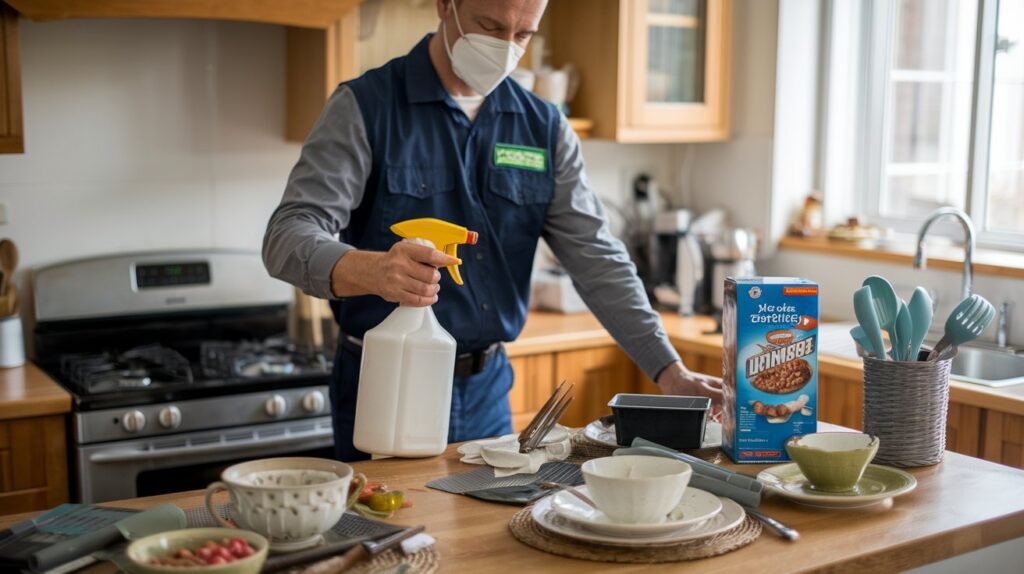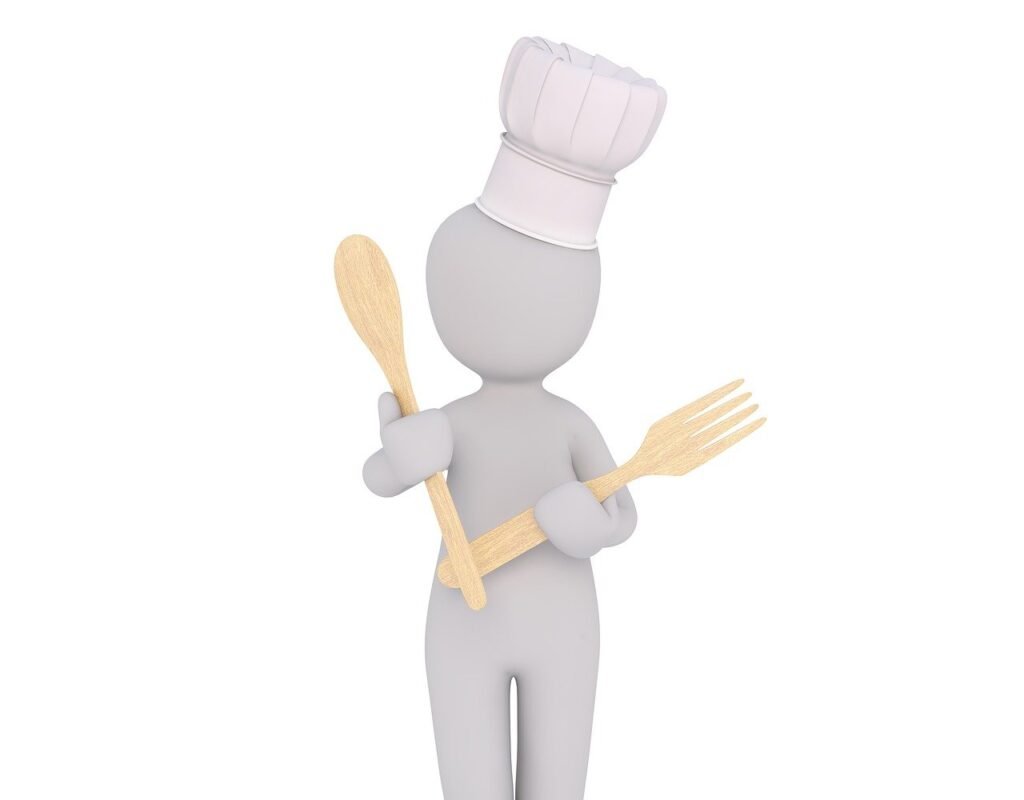Partnering with a pest control company is a smart move, but to get the best results, it’s essential to know what to do before pest control comes .
Sometimes, it is essential to contact a pest control specialist as you might find early signs of pest infestation. But you must get your home prepared.
With simple safety tips, you can ensure your family’s safety, your treatment’s effectiveness, and your food’s uncontaminated status.
In this post, I’ll tell you 5 of the most effective and easy safety practices to ensure effective treatment without affecting your health.
My tips will be:
- Gather information
- Keep your family safe
- Store Food Properly and Securely
- Cover or Remove Kitchen Utensils and Equipment
- Shut Off and Protect Kitchen Ventilation Systems
Gather information

When thinking about what to do before pest control comes, step one is all about gathering information.
Before the exterminators arrive, it’s important to know what they’ll be using and how it will impact your kitchen and home.
Let’s face it: pest control chemicals can be powerful and may cause harm. So, the more we know, the better we can prepare!
First, call or email the company to ask about their treatment methods.
What type of chemicals or traps do they plan to use?
This is crucial because different methods require different precautions, especially when food and family safety are involved.
After all, we don’t want to risk chemical contamination of our food items!
Ask if the treatment is safe around food prep areas or if additional steps are needed to protect surfaces.
Some pest control companies also offer eco-friendly options—always a great choice if you’re concerned about harsh chemicals in the kitchen.
We can also check if they recommend staying out of the treated areas for a certain time. Knowing this in advance will help us plan.
Finally, awareness is the key.
Do not hesitate to ask for any safety recommendations they advice.
Pest control professionals often have tips on what to do before their arrival that can make the process even safer and more effective.
Keep your family safe
Keeping our families safe during pest control treatments is priority number one.
We may feel ready to tackle pests, but we don’t want any risks for our loved ones!
When planning what to do before pest control comes, one of the most important steps is making sure kids, family members, and pets are kept well out of the way.
If possible, it’s best to arrange for everyone to stay out of treated areas for at least a few hours.
Chemicals used in pest control can linger, even if they’re low-toxicity, and sensitive family members (especially young kids, elderly folks, and pets) might be more at risk.
Let’s play it safe and make a family plan for the day, whether it’s a trip to the park or a day at a friend’s house.
For pet owners, this includes arranging for a safe spot for our furry friends, like a crate in a separate room or a friend’s house.
A bit of extra planning here will go a long way in keeping our homes both pest-free and family-friendly!
Store Food Properly and Securely

When planning a pest control program, storing food properly is a must for kitchen safety.
Keeping food safe from any potential chemical exposure protects us and our loved ones.
Here are some easy steps to make sure all our food items stay fresh, clean, and protected!
1. Use Airtight Containers
Let’s start by storing all our pantry foods—flour, sugar, snacks—in airtight containers.
This keeps any pest control chemicals from seeping into packaging and also keeps pests out in the future!
Choose containers with a tight seal, and double-check that they’re properly closed.
This little step can make a big difference.
2. Move Fresh Foods to the Fridge
For fresh produce, dairy, and meats, the best place is the fridge.
Moving fresh foods here ensures they’re away from pest control products while staying safe to eat.
If the fridge is part of the treatment area, consider temporarily moving these items to another room’s fridge if you have one.
But, be careful, never let them in the temperature danger zone (TDZ) where they can be badly affected by foodborne bacteria.
3. Wrap or Relocate Opened Items
If there are open boxes of snacks or food items that can’t be sealed up, it’s best to remove them entirely from the treated space.
Placing these foods in bags and storing them in a closed cabinet or another room is an easy solution.
After all, a little extra care now means we don’t have to worry later!
Taking these precautions keeps our food safe and fresh, even during pest control.
With these steps, we can be confident that our kitchen will stay pest-free and our food fully protected!
Cover or Remove Kitchen Utensils and Equipment
Before starting the pest control, one crucial step is protecting our kitchen utensils and equipment.
After all, these are the tools we use to prepare meals—keeping them chemical-free is key to maintaining a safe, healthy kitchen!
If our kitchen is the main treatment area, we’ll want to cover countertops, stovetops, and any open shelving.
Plastic sheeting or disposable tablecloths work great for covering large surfaces and keeping them safe from any spray or residue.
After the treatment, it’s a breeze to simply remove the coverings and toss them out.
For items like pots, pans, and utensils, we can either cover them with plastic wrap or pack them away temporarily.
Small appliances, like blenders or coffee makers, should also be either wrapped or moved to a safe area.
It’s a quick step that makes a big difference in food safety.
If possible, place all smaller items in closed cabinets or drawers.
Keeping things in cabinets means fewer surfaces we’ll need to sanitize after the treatment and more peace of mind that our tools are ready to use.
Shut Off and Protect Kitchen Ventilation Systems
As a preparation step before opening our doors to pest control companies, one key area to remember is our kitchen ventilation.
Our ventilation systems like fans, exhaust hoods, and air vents—play a huge role in circulating air.
But during pest control, we want to make sure they’re off and covered.
Why?
Because if chemicals get into the ventilation system, they might spread to other parts of our home.
Here’s how to keep that from happening!
Turn Off All Kitchen Fans and Vents
Before pest control begins, let’s switch off all fans and vents in the kitchen.
This stops any airborne particles from entering the system and reaching other areas.
It’s a small step, but it makes a big impact on keeping our kitchen safe and contained.
Cover the Vent Openings
For extra protection, we can cover the vent openings with plastic wrap or even a towel.
This adds an extra layer of security, making sure that no residue or fumes can make their way through.
Consider this as one element when you are planning what to do before pest control comes and the rest of your home will be safe.
Do you think, it ends here?
Once pest control is done, we’re almost ready to relax, but there are a few quick steps to ensure our kitchen is back to being food-safe.
Just like we planned before the pest control arrival, we’ve got a bit of aftercare to keep things in top shape!
1. Give Treated Areas a Wipe-Down
Start by wiping down any surfaces that might have been exposed during treatment.
Use a mild soap and warm water for this, our goal is to clean off any lingering residue.
Focus especially on countertops, cutting boards, and any open shelving.
2. Uncover and Inspect Kitchen Items
If we covered appliances, utensils, or cookware, now’s the time to uncover and inspect them.
Check for any signs of residue, especially on items that might have been near treated areas.
A quick rinse in soapy water will have everything fresh and ready for use.
3. Let the Room Air Out
Lastly, open windows or turn on any kitchen fans to ventilate the area.
This lets any leftover fumes clear out, making the space feel fresh again.
A good 30 minutes of airflow can make all the difference!
Conclusion
Planning what to do before pest control comes is crucial for your safety, a few easy steps go a long way!
Start by researching the pest control company and their treatment methods.
Keep your family, including pets, safely out of the treated areas, and store food properly in airtight containers or in the fridge.
Cover or remove all kitchen utensils and equipment, and don’t forget to shut off and protect ventilation systems.
Finally, after treatment, clean surfaces, inspect kitchen items and let the area air out.
Following these simple steps keeps our kitchen safe and pest-free, so we can enjoy a healthy, happy home!
If you are managing food as your business, and want to know how should pests be controlled in the food business, this post is for you.



